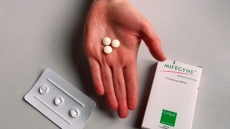TORONTO — If there's one thing Devora Greenspon wants to avoid, it's taking a tumble that could fracture one of her brittle bones, especially a hip.
At 83, the Toronto long-term care resident knows what can happen to seniors who suffer a fall — she's been there and the results can be disastrous.
In her 40s, she slipped on a patch of ice and broke her ankle joint, keeping her in a cast for many months. The joint later had to be surgically fused.
"My back is full of rods, nuts and bolts," said Greenspon, who's had a number of back and neck surgeries.
On her 65th birthday, she tripped on a hole in a sidewalk and broke her shoulder; that joint later had to be replaced.
"I am very afraid of falling," said the senior, who uses a walker.
"And the doctor worries. He says my bones are like butter," she said, adding that he always tells her: "'Don't fall, because all my miracle medicine won't help you. You'll be like Humpty-Dumpty. We'll never be able to put you back together again.'"
It's fractures such as those suffered by Greenspon that Osteoporosis Canada wants to prevent.
On Monday, the organization released a set of guidelines that's aimed at strengthening the bones of long-term care residents to help prevent falls and the damage they can do.
More than a third of older adults who experience a hip fracture are living in long-term care facilities, said Dr. Alexandra Papaioannou, a geriatrician at Hamilton Health Sciences and lead author of the guidelines published Monday in the Canadian Medical Association Journal.
"They're an older, fragile group, but even compared to seniors in the community that are the same age, they often have a number of other diseases, are on a number of medications and have a higher chance of falling," she said.
Almost half of the women living in long-term care who suffer a hip fracture will die within one year, compared to 20 per cent among those in the community. And up to 30 per cent of residents have vertebral fractures, which also increase their risk of death.
Osteoporosis Canada says that in 2010, the annual cost to the health-care system for treating osteoporosis and related fractures was more than $2.3 billion.

Its new guidelines are an adjunct to those published in 2010, which were aimed at helping community-dwelling seniors avoid the disability and the reduced quality of life caused by falls.
"The change is now to reduce the risk of fractures, (and) you need to look at osteoporosis risk factors as well as fall-reduction strategies," said Papaioannou.
One telltale sign of osteoporosis is a loss of height often caused by vertebral fractures, which compress the spine. The disease can also cause ribs to crack — in some cases, just with a sneeze — and lead a wrist or arm bone to snap like a twig during a fall.
The guidelines set out five key strategies for preventing falls, starting with making sure residents have adequate calcium and vitamin D, which work together to strengthen bones.
Seniors in long-term care facilities are often vitamin-D deficient, said Papaioannou, adding that those at high risk of osteoporosis should take supplements of the sunshine vitamin, from 800 to 2,000 international units daily.
Calcium-rich foods probably have the best impact on bones, she said. A daily supplement of 500 mg also could be taken, but the typically large pills can be difficult to swallow, so caregivers will often crush them up in food.
Offering residents hip protectors to prevent an immobilizing fracture is also recommended, as is moderate exercise to improve balance and muscle strength.
The expert panel also strongly recommends that elderly residents with osteoporosis be prescribed a bone-building drug.
"We know that medications are very effective," said Papaioannou. "They reduce the chance of breaking a bone by 40 to 60 per cent, but we know we need to use all of these modalities if we're going to keep the residents safe and independent."
Long-term care homes also need to review what medications residents are taking and whether they "really still need them," she said, noting that drugs like steroids and antidepressants can increase the risk of falls.
Dr. Suzanne Morin, chairwoman of the scientific advisory council for Osteoporosis Canada and a guideline co-author, agreed that the next step is getting long-term care homes and their residents to follow the advice.
"If you tell people it makes sense to prevent falls, it makes sense to ensure that people exercise as much as they can, depending on their co-morbidities, nobody will deny that," the Montreal internist said.
"The problem is it is in a system where people have to do so many things — where do you put this in the list of things you have to do?
"So the idea is to try to make this easier and part of the culture and that's something that the guidelines can do."
For Greenspon, preventing a fall is a priority.

She takes daily does of calcium and vitamin D, is treated with a bone-building drug, and does balance exercises with a physiotherapist. She also spends an hour on a sit-down cardiovascular/muscle strengthening machine three times a week.
"It has increased my bra size — my back has gotten much broader — and I have muscles in my arms and my legs that I never had," she said with a chuckle.
"I'm doing everything I can to keep my end of the bargain."






